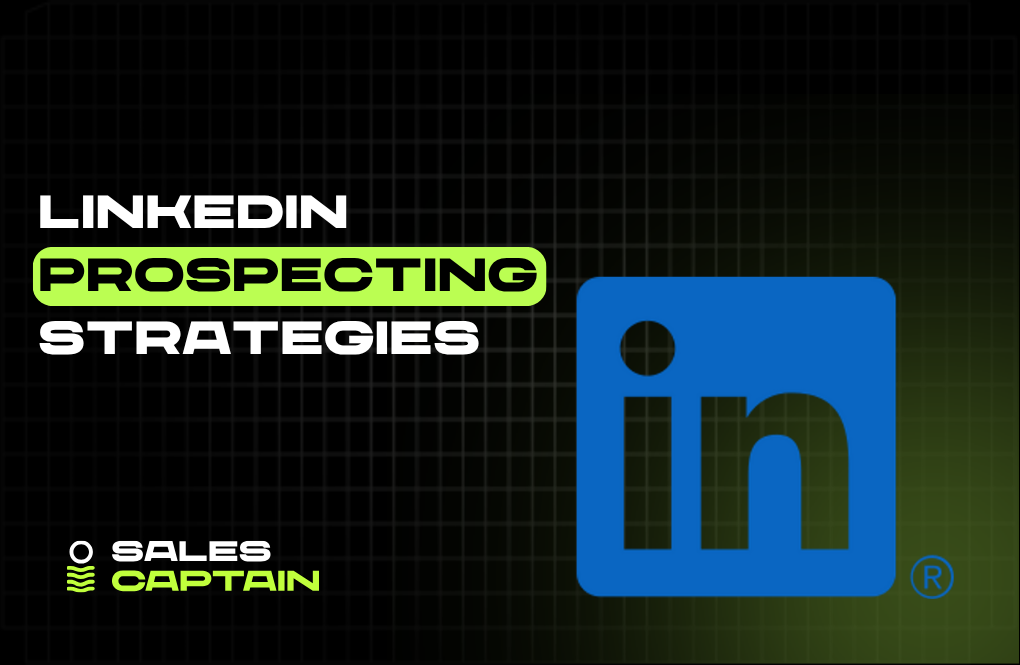

Multichannel Outbound Campaigns: Strategies, Tools, and Best Practices for 2025

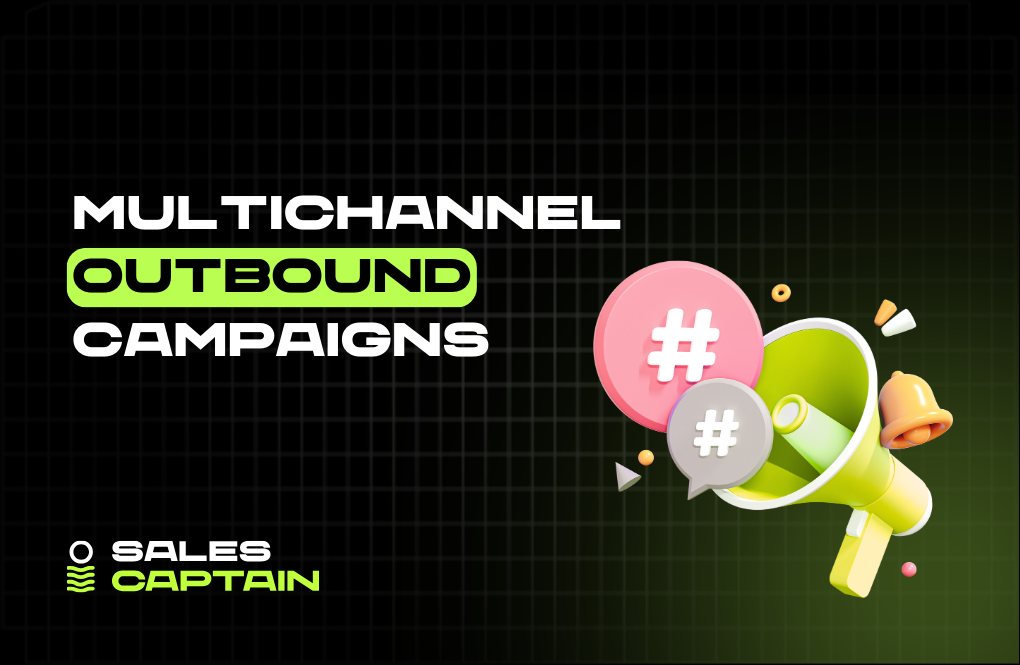
Why Multichannel Outbound Campaigns Matter
Adapting to Consumer Behavior Changes
Prospects don’t live in a single inbox anymore. They bounce between apps, scroll through multiple feeds, ignore calls during the day, and check emails at night. The buyer journey is no longer linear; it’s scattered and fragmented across platforms.
To keep up, your outbound approach needs to mirror this shift. If you're only focused on cold email, you're missing buyers who are more open to a quick LinkedIn DM or who respond better to a warm phone call after seeing a few touchpoints.
Multichannel outreach meets people where they are, allowing for a more personalized approach. It creates more opportunities for touchpoints, builds familiarity, and helps your message land when and where it's most effective.
Increased Engagement and Conversion Rates
Outreach that spans multiple channels doesn’t just feel more human, it performs better. Each channel has different strengths. Email is great for detail, calls build urgency, social builds trust, and direct mail creates a pattern interrupt.
When done correctly, multichannel marketing significantly increases reply rates, meeting volume, and deal velocity. Why? Prospects don’t ignore you. You show up more than once, in different ways, with consistency. That makes it harder for them to write you off.
It’s not about being everywhere just to be everywhere. It’s about orchestrating timing, targeting, and messaging so the right impression hits at the right time.
Staying Competitive in the Market
Think of outbound like paid ads five years ago. The early adopters crushed it cheaply. Then it got noisy. Now, single-channel cold email is saturated. Response rates are down. Spam filters are smarter. Buyers are savvier.
Multichannel isn’t optional anymore. It’s foundational. If your competitors are using smart multichannel cadences, and you’re still hitting send on generic emails, you’re invisible. Or worse, forgettable.
The bar has risen. So has buyer tolerance. Companies that treat outbound marketing as a coordinated effort will win. Everyone else will just… send more emails.
Understanding Multichannel Outbound Campaigns
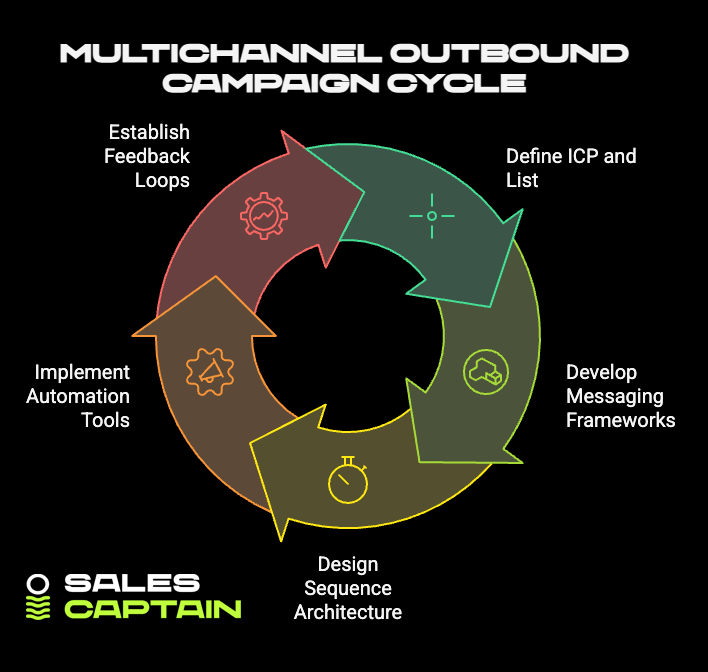
Defining Multichannel vs. Single-Channel
Single-channel outbound is the classic motion, typically email, sometimes phone. You’re betting on one shot to catch attention. And when that channel fatigues or fails, your pipeline dries up.
Multichannel outbound means spreading your outreach across 2–4 different channels, email, LinkedIn, phone, maybe even SMS or direct mail. It’s strategic repetition. You’re not sending the same message across every platform. You’re designing a journey.
It's not spray-and-pray. It’s system-level orchestration. The shift here is mental: outbound isn't just a sales hustle anymore. It's a full-stack growth campaign that spans tools, data, content, and workflows.
Key Components of a Multichannel Campaign
A real multichannel campaign doesn’t start with "send this email." It starts with a system:
- A clear ICP and segmented list
- Channel-specific messaging frameworks
- A sequence architecture (timing, delays, touchpoints)
- Tools for automation and tracking (like Clay or Zapier)
- Feedback loops for optimization
You need tight workflows and clear attribution to know what’s working. That takes more technical precision than what legacy SDR teams were built for. Which is why many GTM teams are hiring operators, not reps. Or working with outbound partners like SalesCaptain to accelerate execution.
Identifying Effective Channels for Outreach
Platforms to Consider: Email, Social Media, and Phone
Three of the most reliable B2B outbound channels are still email, social, and phone. Each has its place; what matters is how and when you use them.
- Email: Direct, scalable, easy to automate. But needs quality copy and domain warming.
- Social (mostly LinkedIn): Warms up cold emails, builds personal brand credibility, offers low-friction touchpoints.
- Phone: Still the most direct way to create urgency. Best used after email + social to avoid “who is this?” reactions.
Multichannel isn’t about volume, it’s about sequence. A no-reply email doesn’t mean no interest. Maybe they need to hear your name again on LinkedIn before replying. Maybe a brief call after the DM is what gets the deal moving.
Integrating Traditional Methods: Events and Direct Mail
It’s not all digital. Old-school outreach can stand out when coordinated well.
Events, whether virtual or in-person, are underrated B2B touchpoints. They offer social proof, natural momentum, and a warm context for follow-up sequences. A prospect who saw your talk is 10x more likely to engage than one who gets a cold email.
Direct mail cuts through digital noise. Think handwritten notes, dimensional mailers, or even targeted swag drops. Not scalable for mass outreach, but lethal for high-value accounts. Especially when paired with digital retargeting or follow-up messaging.
Assessing New Emerging Channels
SMS, Slack DMs (for community-led orgs), WhatsApp in global markets, or in-app messages, new channels keep emerging. But don’t chase everyone.
Start by testing what your buyers use. Are they texting leads? Engaging in niche Slack groups? Responding to voice notes on LinkedIn? Tap into their native behaviors.
Use tools to experiment fast and scale what works. Then bake the winners back into your multichannel system. What’s emerging now could be table stakes in 6 months.
Crafting Targeted Messaging for Each Channel
Tailoring Content for Specific Audiences
Spray templates don’t work. Not anymore. Buyers can sniff out generic sequences in seconds.
Whether you’re selling to operations folks, founders, or IT directors, the hook needs to resonate with their specific pain or ambition. Timing matters. So does context.
Multichannel messaging forces you to think per persona, per platform. What works in a cold email won’t hit the same in a LinkedIn comment or a 30-second voicemail. Each touchpoint has its own tempo.
Tone and Style Consistency Across Platforms
Personalization is key, but tone matters too. Your brand voice, whether it's casual, punchy, analytical, or consultative, should feel coherent across channels.
That doesn’t mean copy-paste. It means alignment. A DM shouldn’t sound like a legal memo. A voicemail shouldn’t treat someone like just another lead in the funnel.
Consistency builds trust, which builds reply rates. Big difference between "Who is this?" and "Oh yeah, I’ve seen their stuff before."
Creating Buyer Personas for Enhanced Relevance
You can’t write what resonates if you don’t know who you’re writing for.
Well-built buyer personas go deeper than job title. They include:
- Day-to-day frustrations
- Metrics they own
- The tech they use
- The language they speak
- Triggers that spark urgency
These insights guide messaging, channel choice, and timing. They don’t come from guessing; they come from interviews, closed-ended analysis, and behavioral data.
Your sequence doesn’t start when someone receives an email. It starts when you create messaging that actually makes them stop scrolling.
Steps to Implement a Successful Multichannel Campaign

Define Your Campaign Goals
Start with the outcome. Is this campaign for booked calls? Partnerships? Product validation?
The goal defines the structure, copy tone, channel mix, and measurement rules. Without one, you’re just sending stuff.
Campaigns should have a single, measurable objective. That’s what keeps the strategy tight and allows you to optimize.
Map Out the Customer Journey
Most outbound campaigns die because they skip customer journey mapping. People assume awareness. Or copy-paste generic pain points.
Great campaigns visualize the buyer journey from zero to “interested.” What objections come up? What micro-qualifiers are needed? What value do they need at each stage?
Mapping this journey helps sequence the right message, in the right tone, on the right channel.
Develop a Multichannel Engagement Sequence
Think in stages, not sends. Multichannel sequences typically flow like:
- Intro email with a clear pain or insight
- LinkedIn view or soft-follow
- Comment or DM that references relevant context
- Follow-up email nudging a small CTA
- Light phone call to surface objections or urgency
- Maybe even a creative touch (like a Loom or mailer) if it’s a strategic account
Sequence length, spacing, and complexity depend on your personas and goals. More channels don’t mean longer cadences, just smarter coordination.
Tools for Automating Outreach
Execution at scale requires tight systems. Manual won’t cut it. You need tools that combine data, personalization, and workflow, without losing the human touch.
- Use Clay to build smart lead lists, enrich data, and trigger channel-specific workflows. It integrates with outbound tools, and using that link gives you 3,000 free credits to get started.
- Use Zapier or Make to bridge gaps between tools.
- Run your initial sequences in wherever your team’s best, be it Instantly, Smartlead, or Apollo, but ground it all in structured data.
Outbound winners don’t just send more. They build systems. Then they let those systems learn, iterate, and scale.
Analyzing Performance and Metrics
Key Performance Indicators to Track
Multichannel campaigns are only as good as the data behind them. Without the right KPIs, you're just guessing.
Start by tracking core outbound metrics:
- Reply rate per channel
- Positive reply rate (not all replies are wins)
- Meeting booked rate
- Conversion by channel sequence
- Drop-off points in the engagement funnel
Don’t just track vanity metrics like email opens or social engagement unless they tie back to the pipeline. Focus on outcomes. High reply rates mean nothing if none of those replies turn into revenue.
Also, go channel-specific. For email, track domain health and bounce rate. For LinkedIn, measure connection acceptance rates and DM engagement. For the phone, look at connect rates and call outcomes.
Patterns across these let you spot what’s underperforming, and what’s breaking through.
Tools for Monitoring Campaign Effectiveness
You won't scale without visibility. You need a clear view across platforms, cadences, and personas.
Use a data-enrichment-first workflow. Tools like CRMs or outreach platforms help on the surface, but deeper insight starts with how leads are sourced and routed.
If you're pulling data from multiple sources and running multichannel outreach, unify that with a platform like Clay. It gives you 3,000 free credits using that link and lets you enrich lead data, score behavior, and link performance across tools.
Layer analytics tools or simple dashboards on top of your CRM to track channel sequencing. Know not only what they replied to, but what they saw before that reply.
Track attribution back to the first touchpoint (not last), and identify assisted conversions. In a multichannel setup, that context is critical.
Adjusting Strategy Based on Data Insights
The job doesn't end when the campaign is launched. In fact, that’s when the real work starts.
Weekly or bi-weekly performance reviews should be baked into your GTM team’s workflow. You're looking for patterns:
- Are most replies coming after the third or fourth touch?
- Is LinkedIn outperforming email for a specific persona?
- Do replies spike on a certain day or time?
Use that insight to tweak. Change the sequence order. Reframe messaging. Drop low-return channels for certain segments. Or dial up tactics that are winning.
Even a tactical insight, like leads replying more when the CTA is a low-lift ask, can shift strategy and lift conversion.
Outbound isn’t static anymore. It learns. Great teams build feedback loops that feed into every next campaign.
Common Mistakes in Multichannel Campaigns
Ignoring Audience Preferences
Not all buyers want the same experience. Some hate phones. Others live in their inbox. Some reply to personalized memes on LinkedIn. Others ignore everything unless it comes via a known contact.
When outreach is driven solely by what works for your team or what’s scalable, it fails to meet buyers where they are.
This is where data segmentation matters. B2B isn’t monolithic. Your CFO persona and your product manager persona are hanging out in very different places, at very different times, with very different communication preferences.
If you don’t account for that, you’ll be misfiring across every channel.
Overloading Customers with Messages
Too many teams confuse multichannel with more volume. That’s a fast way to land in spam folders, get blocked, or be burned publicly on LinkedIn.
Multichannel isn’t about adding more touchpoints. It’s about smarter orchestration. Relevance and timing beat brute force.
If someone didn’t reply to your email, it doesn’t mean “send another message today.” Maybe it means to view their profile on LinkedIn or interact with content first.
Buyers are sensitive to over-contact. Especially in accounts where several vendors are running outbound at once. The most effective campaigns feel like a natural, minimally invasive journey, not a marketing blitz.
Failing to Maintain Consistency
One voice. One message. Across every touchpoint.
Too many campaigns fall flat because each channel feels disconnected. A casual DM followed by a hyper-formal email. A clever voicemail that doesn't match the tone of a follow-up LinkedIn message.
Disjointed experiences loss of trust. Even when you're testing different messaging styles, brand consistency still matters.
The ideal experience? A buyer hears your name on three different channels, and it all clicks. Same value prop. Same tone. Cohesive. That’s what builds recall and drives replies.
Best Practices for Multichannel Campaign Success
Establish a Clear Call to Action
The more options you give someone, the less likely they’ll do anything.
Every touchpoint, email, DM, and call needs one crisp CTA. Maybe it’s a 15-minute call. Maybe it’s a reply to a pain-based prompt. Maybe it’s watching a 60-second video.
Whatever it is, remove friction. Don’t bury it under long intros or oversell the ask. The most effective CTAs are simple, human, and easy to say yes to.
Also, steer clear of call-to-actions that feel like pressure. “Would love to find time” works. “I need 30 minutes by Friday” doesn’t.
Maintain a Unified Brand Voice
Different channels, same persona. Your tone should echo wherever prospects interact with you.
That doesn't mean every message is identical. It means the vibe is consistent. If your email is rooted in empathy and insight, your DM shouldn’t sound like a bot wrote it.
A clear brand voice keeps campaigns from feeling stitched together. SDRs, marketers, founders, and everyone running outreach should align on the voice. Frontload it in your enablement. Bake it into templates. Then let it flex through personalization.
People remember tone more than text. Make sure it's memorable in a good way.
Regularly Review and Revise Strategy
No outbound system stays perfect. Market shifts, inbox fatigue hits, formats burn out. What worked in Q1 could flop in Q3.
Use retros the way you’d do them in product: What failed? What unexpectedly converted? What friction did voice?
If your reply rates are sliding, don’t just rewrite copy. Audit your sequence logic, your ICP assumptions, and your channel order.
Great campaigns aren’t launched and left alone. They’re living systems, monitored, tuned, and elevated. Winning teams review weekly, revise monthly, and rebuild quarterly.
Future Trends in Multichannel Outbound Campaigns
The Growing Role of AI and Automation
Outbound has shifted from labor-intensive hustle to system-driven execution. AI plays the central role now.
From dynamic lead enrichment to instant message generation, automation has overtaken manual workflows. Operators can now build sequences that adapt based on persona, behavior, and channel performance, at scale.
The rise of tools that can scrape data, personalize copy block-by-block, and sequence touches automatically means the old-school way (mass emails, huge SDR teams) is dying fast.
Outbound is now a technical motion. The best campaigns feel 1:1, even when they’re happening in bulk behind the scenes.
Increased Focus on Personalization
Buyers can tell within seconds if you’re using templates. The bar for personalization keeps rising, and tech is doing the heavy lifting.
Modern outbound campaigns are moving beyond first-name inserts. Smart data layering means you can personalize based on:
- Tech stack insights
- Hiring changes
- Social activity
- Behavior signals (content viewed, emails opened, links clicked)
What used to take hours now takes seconds using the right stack. Persona-informed, channel-aware messaging is the baseline now, not a nice-to-have.
Predictions for Channel Effectiveness
Email will stay foundational, but its dominance is fading. Here's where the smart bets are heading:
- LinkedIn will keep growing for high-intent interactions
- SMS might rise in certain verticals (e.g., logistics, field ops)
- Video + async voice (like Loom or LinkedIn voice DMs) will cut through noise
- Slack and niche communities will play a bigger role in startup-led ecosystems
Traditional cold calling? Still alive, but now part of smarter sequencing. Not as a first touch.
What’s clear: Channels aren’t going away, but how you use them will matter more than which ones you choose.
Case Studies of Successful Multichannel Campaigns
Analyzing What Worked for Top Brands
Some of the fastest-growing GTM teams don’t just use multichannel. They engineer it.
Take one B2B fintech startup that built near-full-funnel sequences. They combined cold email, retargeting ads, LinkedIn engagement, and founder-led DMs. When someone replied, the follow-up was tailored to where they came in from, which boosted meeting rates by 3x.
Another example: an AI SaaS company targeting operations leads used direct mail with LinkedIn orchestration. They sent custom notebooks with a QR code leading to a Loom. Pair that with a few contextual follow-ups, and reply rates jumped from 8% to over 25% mid-campaign.
The win wasn’t volume. It was thoughtful sequencing and message alignment across touchpoints.
Key Takeaways from Real-World Examples
- Clean data beats clever copy. The more signal-rich your targeting, the better every channel performs.
- Personalization at scale is real, but only with the right systems behind it.
- Single-threaded outreach is a growth cap. Multichannel isn’t optional. It multiplies touchpoints and trust.
- Campaigns that involve founders or use outbound operators (or agencies like SalesCaptain) for execution speed and scale often outperform internal-first attempts.
- The best campaigns don’t just aim for meetings. They orchestrate momentum.
What these campaigns prove: multichannel isn’t a tactic. It’s a GTM operating system. The more you treat it like one, the more it compounds.
Tools to Facilitate Multichannel Campaigns
CRM and Marketing Automation Platforms
Your multichannel system is only as strong as its infrastructure. CRMs and marketing automation platforms are the backbone. They store contacts, track touchpoints, and (if set up right) orchestrate workflows across email, phone, social, and beyond.
The must-haves:
- Multichannel logging and tracking
- Sequence management
- Contact-level insights
- Behavioral triggers
HubSpot and Salesforce are obvious picks, especially when integrated with outreach tools. But their power depends on how workflows are configured. If leads flow in from multiple platforms but aren’t synced back into your CRM, your campaigns turn blind.
For teams that want more flexibility and data depth, pairing your CRM with Clay creates a sharper edge. Clay lets you enrich leads, trigger multi-platform outreach based on custom filters, and unify data flows that typical CRMs silo. That link gets you 3,000 free credits to try it out.
If outbound is a system, your CRM is the control panel. But only if it's wired for it.
Analytics and Reporting Software
What’s working? What’s tanking? Which touchpoint moved the needle? Without analytics stitched into every layer, you’re flying blind.
You need tools that handle:
- Conversion attribution
- Channel sequence analysis
- Persona-based performance
- Real-time feedback loops
Native reporting in platforms like Apollo or Outreach can give you surface-level insights. But most campaigns need deeper visibility. Especially if you’re combining email, LinkedIn, ads, and call cadences.
That’s where tools like Tableau, Looker, or even layered dashboards in Airtable or Google Sheets (built on top of CRM exports) come in. Track response curves. Match actions to outcomes. Spot bottlenecks across persona, channel, or sequence stage.
Better yet, route that data back into Clay to auto-adjust future sends or update lead scoring dynamically.
Data doesn’t lie. But it does need to be looked at in layers.
Communication Tools for Team Collaboration
Multichannel campaigns aren’t run in silos. Your SDRs, marketers, and ops folks need a shared system to collaborate, adapt, and stay aligned on who's hitting what message, where, and when.
Slack (with smart channel setups) often acts as ground zero. Tie in email reply alerts, CRM pings, and performance snapshots. It keeps real-time campaign coordination fast and low-context.
Notion or ClickUp can help with campaign planning docs, buyer persona briefs, tone guidelines, or even competitor collateral analyses.
What matters most isn't the tool. It’s whether your team can share feedback loops in real time. Multichannel wins depend on orchestration, and orchestration fails without clean communication scaffolding.
Getting Started with Multichannel Outreach
Quick-Start Checklist for Your First Campaign
First multichannel campaign? Don’t overcomplicate. Just nail the fundamentals.
✅ Define your ICP and narrow your list
✅ Pick 2-3 channels max (start simple: email + LinkedIn + phone)
✅ Draft message blocks per channel (not just copy-pasted templates)
✅ Set campaign goals (meetings, replies, signal collection?)
✅ Build a 5–7 step sequence that alternates touchpoints
✅ Set up tracking for each touch and capture attribution
✅ Launch a small batch first. Monitor replies and time-to-response.
You’re not aiming for scale here. You’re testing for signal. Once you have a baseline, you can layer in automation, more personalization, or new channels.
Trying to scale before you have a message-channel fit is like stepping on the gas when your GPS is still loading.
Useful Templates for Campaign Planning
You don’t need a blank doc every time. Templates accelerate execution and keep alignment across teams.
Use these as starting points:
📄 Campaign Blueprint Template
Map sequence across touchpoints, assign messaging owners, and define timing cadences.
📄 Message Matrix
Rows = personas. Columns = channels. Each cell = your value prop tweak + CTA.
📄 Objection Handling Sheet
Top responses you anticipate, mapped to fast follow-up messages or talk tracks.
📄 Engagement Heatmap
Monitor response data over time to find the hot zones: which channel + message + day combo is converting.
You can build these in Notion, Airtable, or inside your CRM. Doesn’t matter where. What matters is making your process repeatable and scalable without losing nuance.
Multichannel isn’t “run campaign, hope for replies.” It’s orchestration. And orchestration runs smoother when you’re not reinventing the structure every time.
It’s not just email. It’s not just calls. A multichannel outbound campaign is a coordinated sequence of touchpoints across multiple platforms, including email, LinkedIn, phone, SMS, and direct mail, that move a cold prospect toward conversion.
But it’s not just “more channels = better.” It’s cadence, timing, and message cohesion that win. The end goal? Get attention, build trust fast, and spark action.
Outbound used to mean spamming inboxes. Now it means designing journeys.
Start with your buyer, not the platform.
Where do they hang out? What communication do they trust? Are they online all day or unreachable during work hours?
Founders might reply to a punchy email or DM. Enterprise champions may need multi-threaded engagement across phone and LinkedIn before acting. Ops managers skew asynchronous. Field leaders respond better to SMS or 15-second voicemails.
Use existing customer data. Ask recent closed deals what channels they responded to. Or test in micro-batches using tools like Clay to segment and target by behavior or tech usage.
You don’t need five channels. You need the two or three that actually fit how your buyer moves.
Forget open rates. Here’s what matters:
- Reply rate (per channel)
- Positive reply rate (qualified interest)
- Time-to-reply
- Meeting booked rate
- Conversion by channel sequence
- Assisted conversion (touchpoints that didn’t get replies but warmed the deal)
Track across personas, not just sequences. Your ops persona might ghost email but spike on LinkedIn. Those insights aren’t surface-level; they shape your next campaign.
And more teams are also tracking cost per reply and cost per meeting across channels. Especially when campaigns are run through agencies like SalesCaptain or involve paid tools.
Outbound without numbers is just noise.
Go past {first_name} and {company}. That’s not personalization. That’s mail merge.
Real personalization starts with data signals. What tech do they use? Are they hiring? Did they post on LinkedIn recently? Have they engaged with content or signed up for something recently?
Tools like Clay can scrape and enrich profiles with those kinds of insights so you can write persona- and trigger-based messages at scale.
Use frameworks like:
- “Saw you’re hiring in X, which likely means Y pain point…”
- “Noticed you recently switched to the X tool, here’s what that typically breaks…”
The more context, the more reply-worthy your outreach becomes. Especially when the messages aren’t robotic, but conversational, timely, and grounded in relevance.
Personalization isn’t a field insert. It’s a signal-driven system.
RELATED ARTICLES
Check out more articles on our blog!
RELATED ARTICLES
Lorem ipsum dolor sit amet, consectetuer adipiscing elit, sed diam nonummy nibh euismod tincidunt ut laoreet dolore magna aliquam erat volutpat.

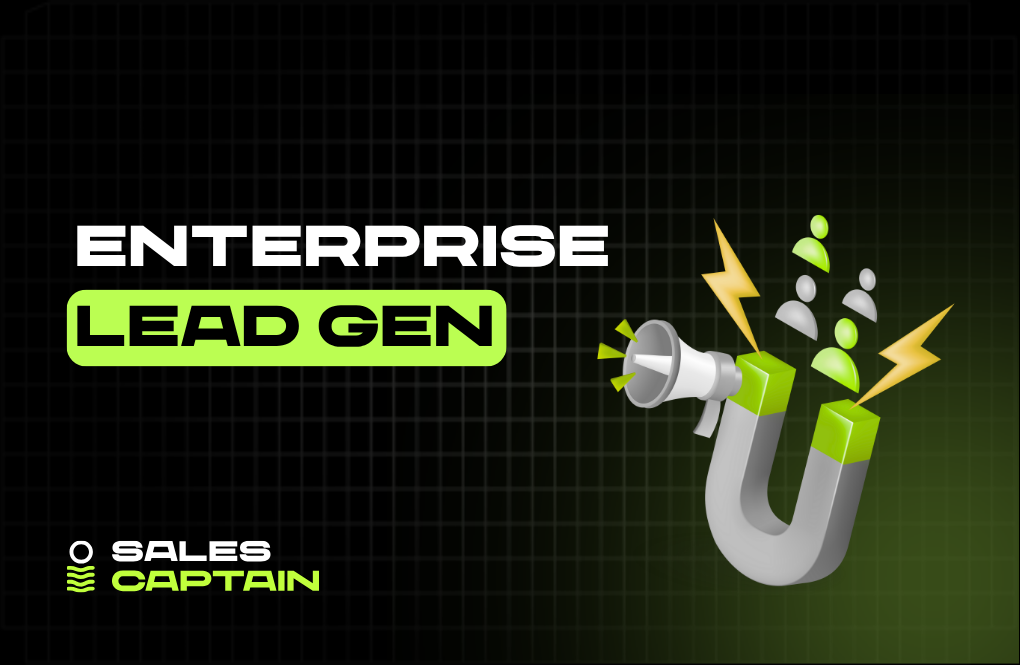
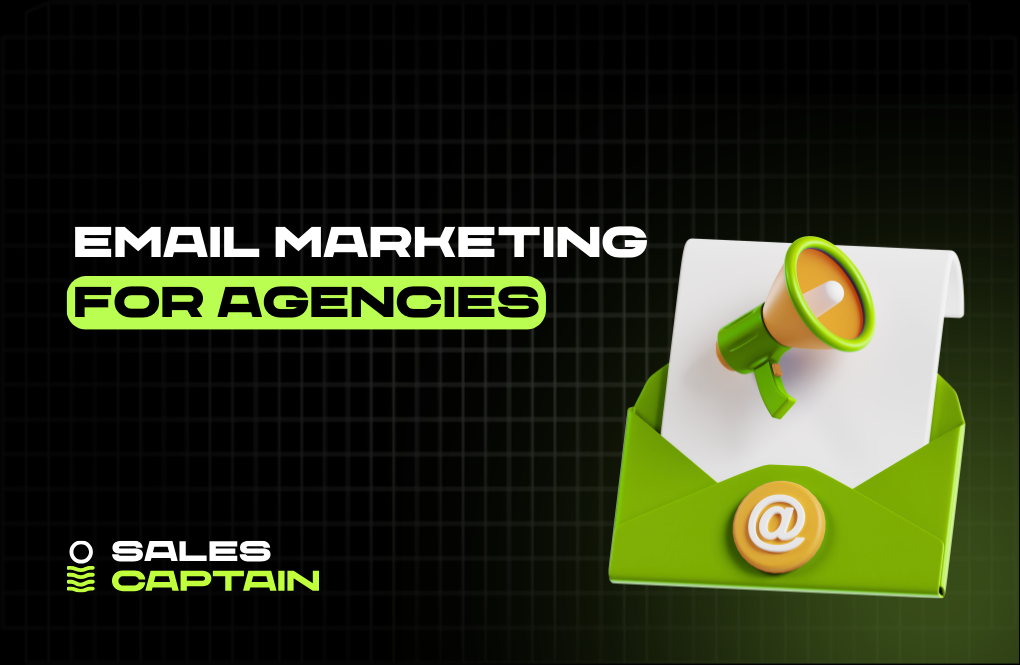

.jpg)
